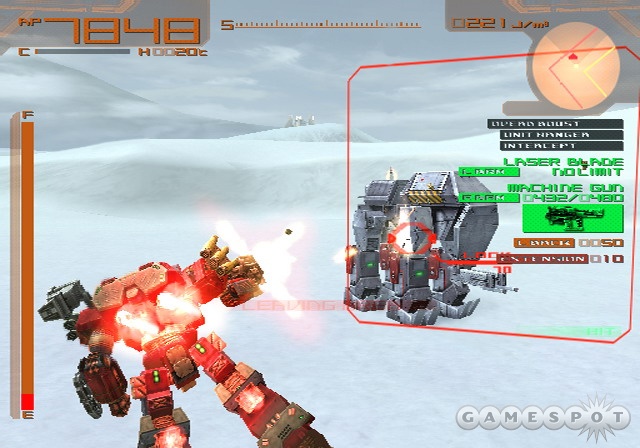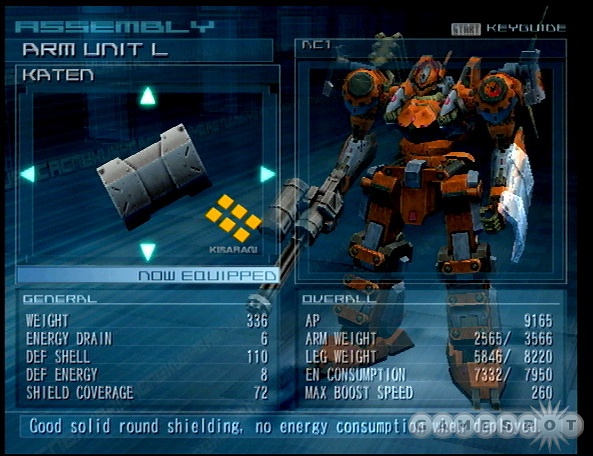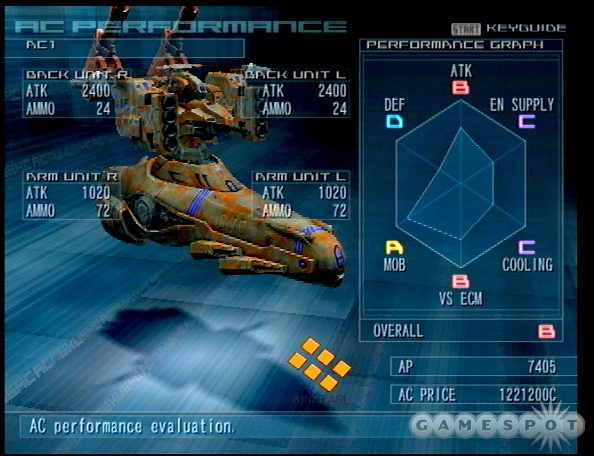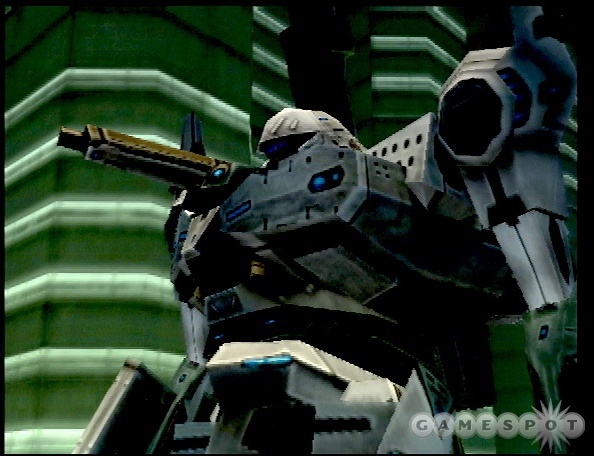Now in its eighth installment--and its fifth on the PlayStation 2--the Armored Core franchise continues to take the concept of robot combat further and further. Armored Core: Nexus, the latest game in the series, doesn't significantly overhaul the basic aspects that diehard fans have come to enjoy, but it does flesh out a few features that were underdeveloped in previous installments. The game's overall difficulty has been ratcheted up thanks to improvements in mission design and enemy behavior, and formerly incidental aspects, such as heat dissipation, lock-on capability, and energy consumption, now factor much more heavily into robot construction than they did in earlier games. Aside from just being more thought-provoking and challenging than its predecessors, Nexus also takes customization to the nth degree by offering more than 400 different interchangeable parts and weapons, as well as the ability to tune individual parts to suit specific needs. The things this latest game doesn't change, however, are the sluggish play mechanics, gritty graphics, and low-key audio that have been common to every installment in the franchise since it first appeared. For all these reasons, established fans who haven't yet tired of the franchise's core elements will probably get the most out of Nexus, although newcomers shouldn't be afraid to take the plunge into this sim-heavy robot-battle game, either--so long as they're willing to invest the many hours that are necessary to become proficient at it.

Nexus comes packaged as a two-disc set. The first disc, titled "Evolution," contains 100 missions centered around the new story arc, which is merely a fast and loose plotline involving a mercenary for hire and his experiences working for rival mining corporations. Disc two, entitled "Revolution," contains 40 missions taken from previous installments in the Armored Core series that have been made over to take advantage of the new game's graphics engine and robot-design interface. This last disc also includes a litany of earned secrets, such as music, movie clips, emblems, posters, and concept artwork spanning the entire history of the franchise. Both discs offer a versus mode with support for up to four players, either by split-screen (on one PS2) or LAN setup (using four PS2s equipped with network adapters and four monitors). Surprisingly, neither disc has anything in the way of an actual Internet-based online mode. Ever since the PlayStation 2 network adapter was introduced, fans have been begging for an online-enabled Armored Core game, and it looks like they'll have to continue waiting.
The general gist of the new game is the same as those of the past. Players assemble a robot, called a "core," and then go out on missions to face enemy cores in ravaged areas or in arenas filled with spectators. Different missions are unlocked, and money is gained or lost depending on the outcome of each battle. Cores come in all shapes and sizes, which means you can put together just about any kind of robot your mind can conjure up. You can assemble bodies supported by humanoid legs, insect legs, quad legs, tank treads, or hover suspensions. You can attach weapons--such as guns, lasers, rocket launchers, and swords--to the arms and shoulders of your robot. Then you can accessorize the whole thing with thrusters, cooling systems, and radar units. Finally, you can take the end product out on to the battlefield to see how well it fares.
Experienced Armored Core vets will find themselves right at home with the game's sluggish controls. Walking, stopping, and turning all incorporate slight response delays based on the theory that a 10-ton robot has a fair amount of weight and momentum acting on it. Meanwhile, other factors, such as recharge time, reloading, and recoil, have an influence over the overall accuracy and usefulness of weapons during battle. Nexus isn't a complete rehash, however. The controls have been changed to a dual analog piloting system that's more in line with traditional first-person shooters. As a result, the left stick causes the robot to walk, and the right stick controls the steering and aiming functions. Firing and weapon-selector controls are situated on the shoulder buttons, while the face buttons are used for dropping weapons and activating internal systems. Newcomers may be overwhelmed at first, both by the intricate controls and the slow-paced handling of the robots--not to mention the glut of more than a dozen onscreen displays. However, the trade-off is that the game totally makes you feel like you're in charge of every aspect of your robot's travels. Players that want to use the classic control setup can still do so by enabling it from the option menu.

While the new control interface might suggest that developer From Software is trying to attract players who haven't had much experience with the franchise, it's sure made a bunch of other changes that suggest longtime AC vets will have an easier time acclimatizing to Nexus than newbies will. The time limits and destruction quotas that underpin most missions have been made stricter, and the design of each mission calls for a lot more planning. Some missions require the use of sniper weapons just to hit enemy targets, while others set up melee situations where machine gun and blade weapons work best. Still others emphasize the use of thrusters and jamming systems over all-out gunplay. Enemy cores also carry better weapons and armor this time around, and they're much smarter, too. Rival cores will boost into the air and duck behind structures to avoid your shots. They'll jerk side-to-side to make it tougher to lock on to them, set you up for two-on-one situations, and won't hesitate to close in for the kill if your armor runs low.
These improvements combine to make Nexus more difficult and more interesting than its predecessors, which is great. However, the one thing the developer failed to do, in turn, was revamp the mission briefings to make them appropriately informative and helpful. Mission briefings don't tell you how many enemies you'll be facing or the kinds of weapons they'll be carrying, and they don't offer advice on the kinds of weapons you should equip for the mission. Since new missions open up and old ones disappear based on your success or failure during a mission, you can't just attempt the same mission over and over again until you get it right. It would've been nice to at least have had some warning when faced with a mission specifically oriented around sniping or fast aerobatics.
Nexus further sets itself apart from previous installments by taking play aspects that used to be minor and making them more significant. There are multiple radar and tracking systems to pick from, each with its own specific range and lock-on capability (near, far, narrow, wide, and average), and certain missions favor using one type over another. Heat dissipation has taken on major significance in Nexus. Every weapon, certain accessories (such as thrusters and armor packs), the act of taking damage, and even the process of walking around in certain environments produces varying amounts of heat inside your core, which automatically dissipates when standing idle but continues to build while moving around or firing weapons. In missions with only a few enemy cores, it's OK to both outfit your own core with high-energy weapons and hover in midair for extended periods. But in missions where there are dozens of enemy cores and gun placements, or where you have to stay constantly on the move, it's a good idea to both customize your core with efficient weapons and sacrifice mobility for a stronger cooling system. Cooling systems speed up the rate at which your core dissipates heat.

All of these different items (weapons, tracking units, cooling systems, and more) eat up energy, which is another aspect that players have to pay more attention to in this latest game. If you build a heavier, more complex core with powerful weapons, you'll need to buy and install a generator powerful enough to run it all. Of course, the generator's weight and heat production also factor into both the mobility of your core and the type of cooling system you'll need for it. It's just this sort of obsessive, vicious cycle that draws people to the Armored Core series year after year.
Customization has always been an integral aspect of Armored Core games. This time around, there are more than 400 individual parts and weapons to pick from, as opposed to roughly 200 in the last game. A single core can be built from as few as eight individual parts, or upward of 20. Every weapon and part is rated in a number of categories, such as firepower, ammo capacity, energy consumption, lock-on capability, weight, cooling use, defense, accuracy, mobility, and so on. The performance rating of some parts can also be improved by spending money to research upgrades. Putting together a useful core requires a great deal of time and effort in going over the various ratings, analyzing the weight and heat consequences of the combinations you come up with, and then testing the end result in the test garage before you take it out on a mission. The customization system is ridiculously overwrought with menus and option toggles, which can become very overwhelming due to all the backtracking involved, but (again) the trade-off is the feeling that you're involved in every aspect of the core's existence, from its creation to its survival.
Despite the various enhancements made to the game's hands-on aspects, the graphics and audio in Nexus aren't any better than they were in Armored Core 2, which came out in 2000 and was the PS2's first Armored Core game. Every interchangeable part is highly detailed, and there are loads of individual animations for walking, aiming, boosting, getting knocked over, and so on. Also, the gunfire and explosions look good, as do the shrapnel and heat distortion effects. However, the environments surrounding everything are plain and lifeless. Even in levels littered with buildings, the scenery fails to impress, because the textures are so simple, and there aren't a lot of destructible environmental features. The graphics are plagued with "jaggies," too, which is a term that describes the shimming and stair-stepping that distorts angular lines in a game that doesn't employ antialiasing techniques. Most games developed for the PS2 in the past few years employ some form of antialiasing. Since Armored Core is based on a graphics engine from 2000, it does not. On the upside, however, sight distance is good, and the jaggies only make it a little more difficult to see enemy ACs that are lurking far off in the background.

The same sort of dichotomies hold true for the audio. Various weapons and parts have their own specific sound effects, and the explosions that accompany the game's action are loud. However, the overall variety of different sound effects isn't that great. Many of them were simply lifted from previous Armored Core games, along with a lot of the music. That's not altogether terrible, provided you don't mind listening to the same pulsing techno and bass beats for four years running. There's also a wee bit of voice dialogue here and there, mainly to proclaim mission successes or failures. Otherwise, the entire story is told through mock e-mail messages that you receive throughout the course of the game.
Fans and newbies alike have been waiting patiently for the Armored Core franchise to take advantage of the great advances in graphics, audio, and online features that have emerged on the PlayStation 2 in recent years. Armored Core: Nexus scoffs at such progress, but it's still a very enjoyable and addictive game, regardless. That's because From Software has taken an already complex and involving game and made it even richer by expanding the variety of customization options available, in addition to giving players an even larger array of aspects to concern themselves with when building and using their own giant robots.